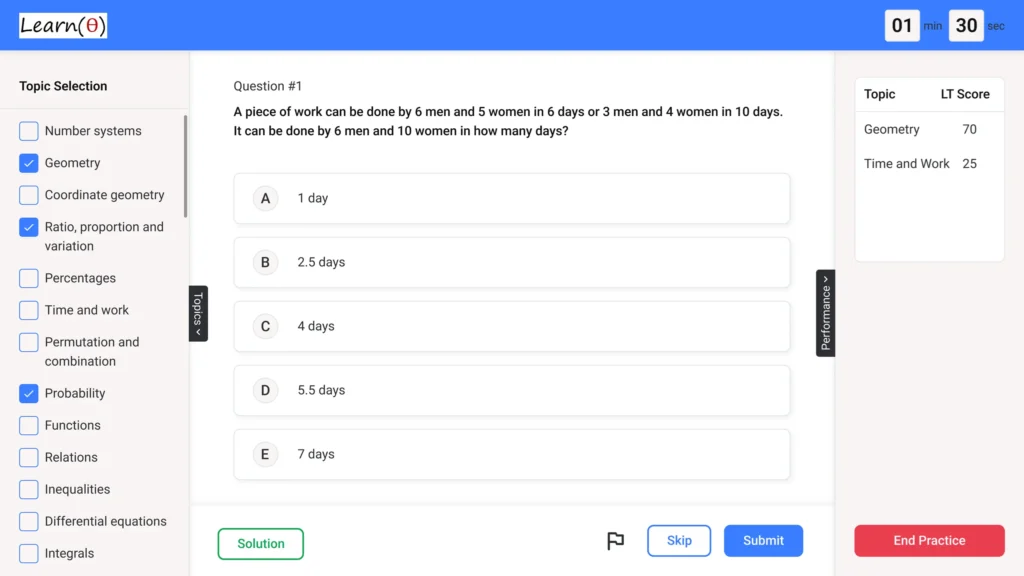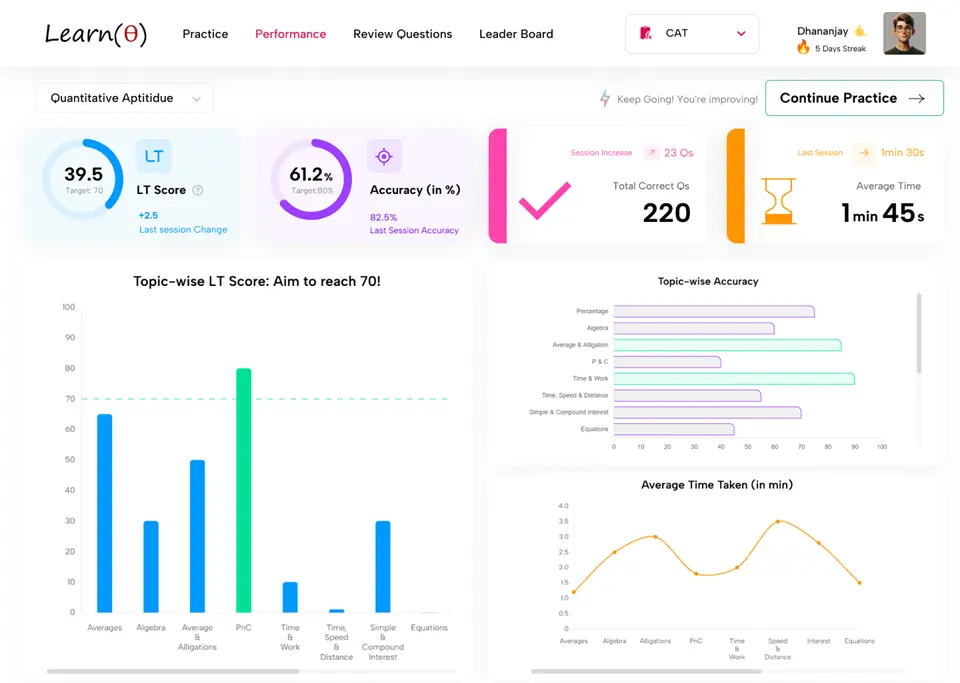Cisco – Aptitude Questions & Answers for Placement Tests
Reviewing Previous Year Questions is a good start. Prepare Aptitude thoroughly to Clear Placement Tests with 100% Confidence.
Q.1 What is the equation of the line perpendicular to the line y = (1/2)x + 3?
Check Solution
Ans: B
The slope of the given line is 1/2. The slope of a perpendicular line is the negative reciprocal, which is -2. The equation of the perpendicular line can be represented as y = -2x + c, where c is the y-intercept.
Q.2 An article is sold for Rs. 1800 after a discount of 25% on its marked price. If the cost price of the article is Rs. 1200, what is the profit percentage?
Check Solution
Ans: B
Let the marked price be M. Selling price (SP) = M – 0.25M = 0.75M = 1800. Therefore, M = 1800 / 0.75 = 2400. Profit = SP – CP = 1800 – 1200 = 600. Profit percentage = (Profit / CP) * 100 = (600 / 1200) * 100 = 50%.
Q.3 A can run 100m in 12 seconds and B can run the same distance in 15 seconds. In a race of 100m, how much start in meters can A give B so that they finish at the same time?
Check Solution
Ans: C
A’s speed = 100/12 m/s, B’s speed = 100/15 m/s. Time taken by B to run 100m is 15 seconds. In 15 seconds, A runs (100/12)*15 = 125m. So A can give B a start of 25m.
Q.4 The compound interest earned on a certain sum at 10% per annum for 2 years is Rs. 420. Find the principal.
Check Solution
Ans: B
Let P be the principal. CI = P(1 + R/100)^N – P 420 = P(1 + 10/100)^2 – P 420 = P(1.1)^2 – P 420 = 1.21P – P 420 = 0.21P P = 420/0.21 = 2000
Q.5 A bag contains 5 red balls, 3 blue balls, and 2 green balls. If two balls are drawn at random, what is the probability that both balls are of the same color?
Check Solution
Ans: A
Probability(RR) = (5/10)*(4/9) = 20/90. Probability(BB) = (3/10)*(2/9) = 6/90. Probability(GG) = (2/10)*(1/9) = 2/90. Total probability = (20+6+2)/90 = 28/90 = 14/45
Q.6 A shopkeeper initially marked up the price of an item by 40%. He then offered a discount of 10% on the marked price. What is the overall percentage profit or loss?
Check Solution
Ans: A
Let the cost price be 100. Marked price = 100 + 40 = 140. Selling price = 140 – (10/100)*140 = 140 – 14 = 126. Profit = 126-100 = 26. Percentage profit = (26/100)*100 = 26%.
Q.7 X and Y enter into a partnership. X invests Rs. 12,000 for 6 months and Y invests a certain amount for 8 months. If the profit is divided in the ratio of 9:4, then find Y’s investment.
Check Solution
Ans: B
Let Y’s investment be ‘y’. Ratio of profits = (12000 * 6) : (y * 8) = 9 : 4. Therefore, (12000 * 6) / (y * 8) = 9/4. Solving for y: y = (12000 * 6 * 4) / (8 * 9) = 4000. This calculation contains error. Correct calculation: Ratio of profits = (12000*6) : (y*8) = 9:4 or, 72000:8y = 9:4. therefore, 9*8y = 72000*4, therefore y = 72000*4/(9*8) = 4000. Hence, y*4/9= 12000*6/9. Therefore y = (12000*6*4)/(8*9) = 4000. The correct solution is Rs. 8000
Q.8 What is the remainder when the sum of all 3-digit numbers divisible by 13 is divided by 17?
Check Solution
Ans: C
The smallest 3-digit number divisible by 13 is 104 (13 * 8), and the largest is 988 (13 * 76). The sum of an arithmetic series is (n/2)(first term + last term). The number of terms is 76 – 8 + 1 = 69. The sum is (69/2)(104 + 988) = (69/2)(1092) = 69 * 546 = 37674. Dividing 37674 by 17, we get a quotient of 2216 and a remainder of 2.
Q.9 In a survey, 70% of people like coffee and 60% of people like tea. If every person surveyed likes at least one of the two beverages, what percentage of people like both coffee and tea?
Check Solution
Ans: A
Let C be the percentage of people who like coffee, and T be the percentage of people who like tea. We are given that P(C) = 70% and P(T) = 60%. Since everyone likes at least one beverage, P(C ∪ T) = 100%. We know that P(C ∪ T) = P(C) + P(T) – P(C ∩ T). Therefore, 100% = 70% + 60% – P(C ∩ T). Solving for P(C ∩ T), we get P(C ∩ T) = 70% + 60% – 100% = 30%.
Q.10 In the inequality, 2×2 + 4x – 6 > 0, find the range of x.
Check Solution
Ans: C
2×2 + 4x – 6 > 0 simplifies to x2 + 2x – 3 > 0. Factoring gives (x + 3)(x – 1) > 0. This inequality holds true when both factors are positive (x > 1) or both factors are negative (x < -3).
Next: Coforge Aptitude Questions
Refer Company wise Aptitude Questions
Practice 1000s of Aptitude Questions with Answers for Quant, Reasoning & Verbal
Fastest Way to Crack Aptitude Tests – LearnTheta’s AI-Practice!

✅ All Topics at One Place

🤖 Adaptive Question Practice

📊 Progress and Insights